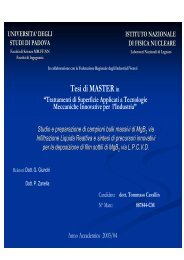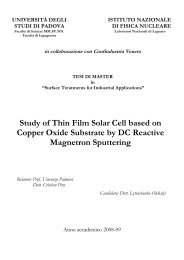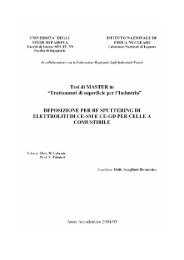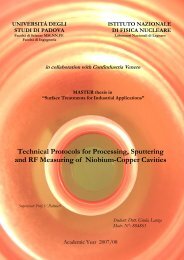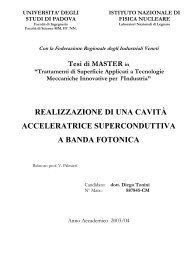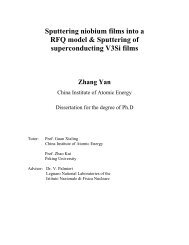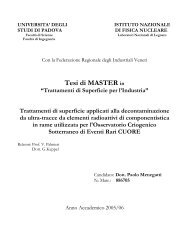Magnetron sputtering of Superconducting Multilayer Nb3Sn Thin Film
Magnetron sputtering of Superconducting Multilayer Nb3Sn Thin Film
Magnetron sputtering of Superconducting Multilayer Nb3Sn Thin Film
You also want an ePaper? Increase the reach of your titles
YUMPU automatically turns print PDFs into web optimized ePapers that Google loves.
stoichiometric composition is metastable at room temperature and is only stable at1940°C. The aluminium content <strong>of</strong> the A15 phase decreases with decreasingtemperature; the homogeneity range at 1000°C is 19~22 at.% Al.Nb 3 GeThe most striking feature <strong>of</strong> Nb 3 Ge phase field is that the stoichiometriccomposition is not included at equilibrium, the highest solubility <strong>of</strong> Germaniumbeing 23 at.%. At 1000°C, the homogeneity range <strong>of</strong> the A15 phase is very narrowand is centered at 18 at.% with total width <strong>of</strong> 1 at.%. It has not been possible torise T C above 17~18 K in bulk sample either by quenching or other means.Metastable stoichiometric, or near stoichiometric, Nb 3 Ge can be prepared as thinfilms with critical temperature <strong>of</strong> 23 K. But the big problem is that the material isvery brittle, which meaning is that a strike or vibration can change the A15structure and cease the superconductor.Nb 3 SnNb 3 Sn is the only A15 material that has given promising results when appliedto the construction <strong>of</strong> a real cavity [19] : Tin was reactively diffused into an Nb bulkcavity and the Q-factor was in the order <strong>of</strong> 10 11 , the accelerating field beinglimited to about 12 MV/m.Fig.1.7The Niobium-Tin phase diagramAccording the phase diagram <strong>of</strong> Fig. 1.7, the A15 phase is unstable below14



